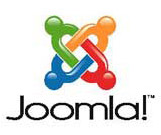Joomla is probably today’s top CMS; popular and adopted worldwide. Extending fairly smaller websites by adding pages is a moderately trivial task; however, for websites that are updated on a daily basis, extending can be a cumbersome task requiring considerate manpower & energy. In this case a CMS presents the best possible solution to webmasters, and Joomla is a great choice.
CMS are special ‘web content management system’ software that are used to maintain website content. The content is stored in a database and then consistently presented in template form which eliminates the need to constantly create HTML pages. A CMS is the easiest way for automated site content management.
Joomla is one CMS that is gaining increasing attention in the web development sphere. Within the first year of release, Joomla’s download exceeded over 2.5 million. In 2009, Joomla Project reported that Joomla was downloaded about 10 million times from their site. It is claimed that there are about tens of millions sites using Joomla over the web today. Joomla is one application that makes the second generation of Internet-based services, commonly referred to as Web 2.0, more likely possible.
Joomla is used for almost all kinds of websites. It can power corporate websites or personal blogs, online malls, online magazines, photo galleries, online newspapers, or to manage an online library of documents & books, videos & podcasts, even chat rooms, and all most every variety of website found on the internet.
Here is a list of some famous websites that use Joomla
http://www.quizilla.com (Social Networking)
http://www.longwoodfl.org (City of longwood-Florida)
http://www.ihop.com (Restaurant website)
http://gsas.harvard.edu (Harvard University)
http://www.outdoorphotographer.com (Outdoor photography Magazine)
http://www.sensointeriors.co.za (Senso Interiors Furniture design Website)
A list of attractive websites developed with Joomla are enlisted on the Joomla official site’s showcase at;
http://community.joomla.org/showcase/
Administration of Joomla
 Joomla administration is managed within an admin panel. All web content like text, photos, and videos are uploaded and managed here. Joomla facilitates remote administration by content approval feature. With this feature you can manage content to be published on your website remotely. You can also assign different levels of access to your website. By this feature you can make available some information for authorized users and hide the information from others. You can also allow editing privileges for some users and disable it for others.
Joomla administration is managed within an admin panel. All web content like text, photos, and videos are uploaded and managed here. Joomla facilitates remote administration by content approval feature. With this feature you can manage content to be published on your website remotely. You can also assign different levels of access to your website. By this feature you can make available some information for authorized users and hide the information from others. You can also allow editing privileges for some users and disable it for others.
Joomla supports a multi-user and multi-level (hierarchical user group management) environment. This implies that users can collaborate for the development of a Joomla-based site.
Content presentation of Joomla
All content on Joomla is stored within a database. You then have the template, modules, and components which together with the content, make up the pages.
Template: This determines the color scheme, complete outlook, fonts and display layout.
Module: Modules perform like display widgets that plug into templates. Elsewhere, modules are called plugins. Examples of common widgets are search box, polling panes, syndication newsfeed, and Who’s Online display. Joomla Menus determine how your site content will be displayed.
Component: The component supplies the main content of the page. Each page displays one component and they can have different functions. On any page the Content Component is responsible for rendering content. Other components may also display all articles available on RSS reader.
As each element can be modified or even replaced, by adding components, changing the template, or including different modules on your page display, a Joomla site can adopt nearly any appearance and provide any functionality that is available from a module or component. Generally, as a user navigates around the site, most of the modules will not change, but the components, in contrast, will vary, depending on the content to be displayed.
Joomla includes complete support for RSS newsfeeds and Atom. Joomla has several WYSIWYG editors pre-installed in Joomla that enable convenient editing on the content online. Joomla also facilitates fulltext searches and has SEO features that make it a best choice for a CMS. You can schedule your content to be published on certain dates using a cron job.
Joomla 1.5.x upwards is capable of supporting right to left languages. As a result, it can attract Hebrew or Arab speaking developers. It is also enriched with extended character sets. Other language packs can be downloaded independently.
Full features of Joomla can be viewed on this page
http://www.cmsmatrix.org/matrix/cms-matrix/joomla
Joomla Templates
http://www.siteground.com/joomla-hosting/joomla-templates.htm
http://www.joomla-templates.com/
http://www.joomla24.com/
http://www.joomlaTP.com/
http://www.joomlaArt.com/
